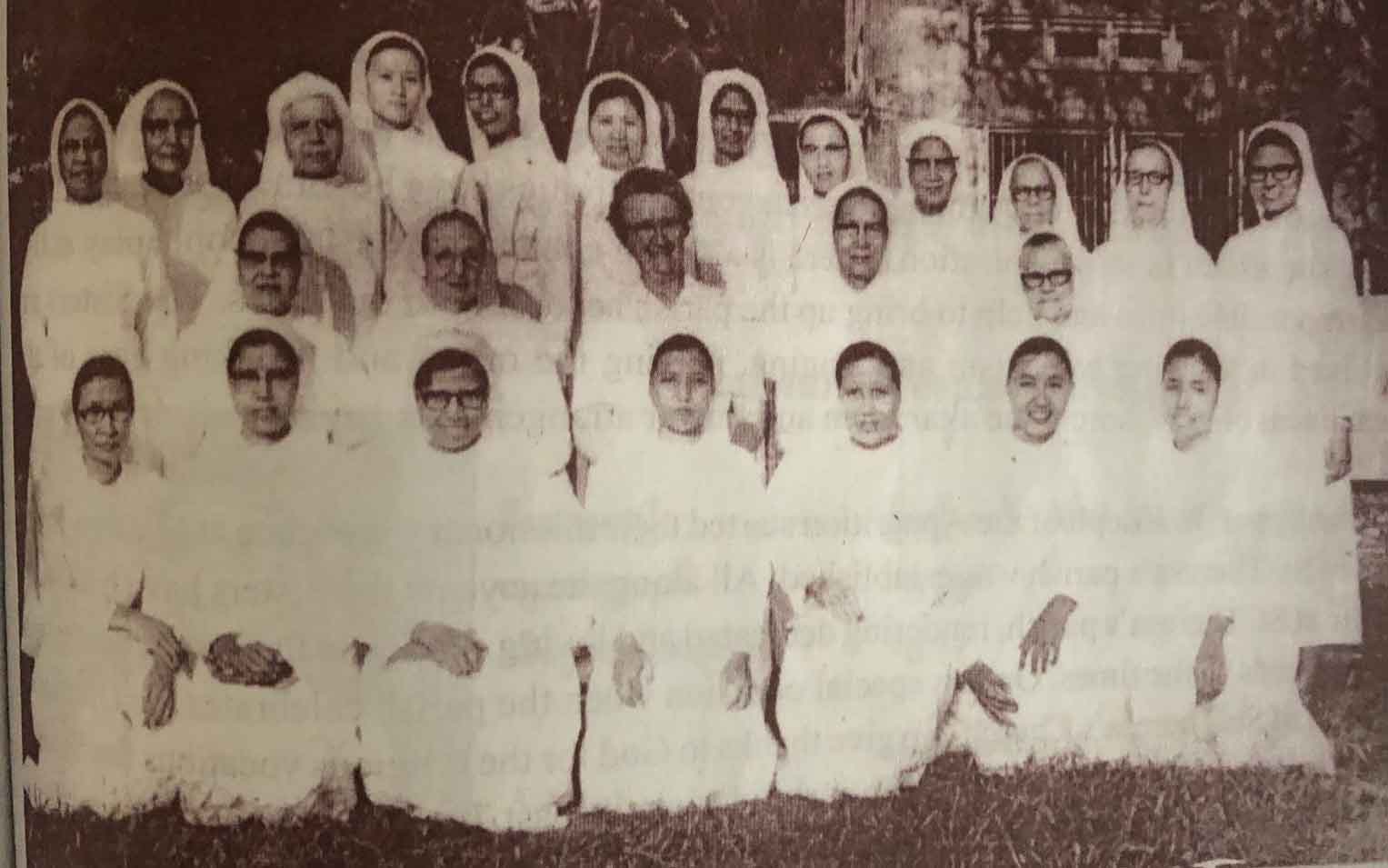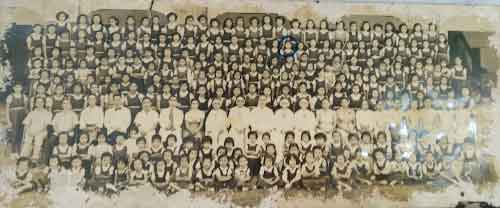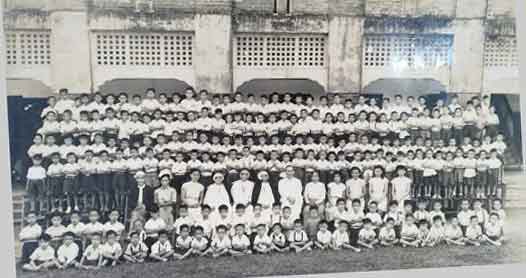The History of Wan Hua Sisters
 |
The Sisters of St. Joseph of the Apparition (SJA) started their missionary presence at St. Theresa’s parish in 1926 and the community was officially established in 1928, just a few months after the establishment of St. Theresa’s Catholic Church. St. Theresa’s or ‘Mission Road’, which is the name commonly used among the Sisters of St. Joseph, has been a sweet home and a treasured mission for many of the Sisters of St. Joseph of the Apparition over the past 93 years.
The Sisters of St. Joseph were invited by the parish priest Rev. Father Germain Allard to take care of Chinese girls and women and to establish a school for the education of young people. Mother Marguerite Rocheteau was the first Superior of the Community. But, in 1928 Mother Marguerite became the Regional Superior and Mother Clotilde replaced her. Mother Clotilde, Sister Noemi, Sister Josephine and Sister Bridget were among the first members of the community at St. Emilie’s Convent, Mission Road. In 1932, Sister Noemi returned to England and to replace her. Sister Dorothy Kiely, the Irish Sister, well known and well loved by all at Mission Road, arrived to start her work of educating young people and above all to be a loving presence in the Chinese Mission.
 |
The Sisters of St. Joseph initiated their mission at St. Theresa’s parish by establishing a school, an orphanage and a boarding department for both girls and boys. Later on, when the pupils became numerous, separate schools were provided - St. Emilie’s Convent and Catholic Anglo-Chinese School. Concerning the initial state of the mission, the following is an extract of Sister Dorothy’s April 1997 letter to the Sisters of St. Joseph, on the occasion of the 150th Anniversary of the SJA Sisters’ presence in Burma.
“The mission was very poor and the parish priest, Father Allard, would go out every month to the rice mills with his catechist to beg for rice, often in a sampan, and come home with bags of rice and other items. At least a third of the pupils were orphans and in addition to feeding we had to clothe them as well. Many of the other boarders were poor and only able to contribute very little towards their upkeep and education. We received from the parish priest 100 rupees a month - the equivalent of £10 which was to cover the needs of four Sisters. However, the cost of living in those days was far cheaper and I do not remember anyone suffering from hunger.
Wealthy parents also sent their children to the Mission School and paid for their education. It delighted me that they all got on so well together. There was no class distinction nor social friction. The pupils took a keen interest in sports and enjoyed competition with other schools. They also took their education extremely seriously and studied very hard. They were a joy to teach. Our school was The Catholic Anglo-Chinese School, but it was not restricted to Catholic. Indeed, I remember that the majority of the pupils were non-Catholic. Among the Catholic pupils, there were very committed groups of Y.C.S. and Legion of Mary and these groups continued to flourish among the pupils even when they progressed to University.”
The school continued to flourish as described by Sister Dorothy till the nationalization of private schools in 1965. For sometime, the Sisters continued to occupy a part of the school building and continued their presence and work among the Catholics at St. Theresa’s parish. When the Europeans left Burma, Mother Theresa Sue, a Chinese sister whose brother was Father Rev. John Sue, became the Superior of the Community at Mission Road. Some time later, the Archbishop of Rangoon asked the Sisters to take charge of the Girl’s’ Hostel at Myenigone, left by the Good Shepherds Sisters.
At the request of the Archbishop, Mother Theresa and the Community left St. Emilie’s and went to live at the hostel in Myenigone. But the Sisters remained the parish Sisters of the St. Theresa’s. They continued to take care of the church, to teach catechism, to take part in parish youth movements, to prepare children for first communion and confirmation and adults for baptism and marriages, to take part in prayer meetings and in the activities of the Legion of Mary and to visit the families in the parish, especially the sick in hospitals or in their homes. Then, Rev. Father John Sue became the parish priest at St. Theresa’s and the two brother and sister were working hand in hand, leading the parish together. With the influence of the remnants of the old schools, the parish flourished and St. Theresa’s Youth became a model in the Archdiocese of Yangon.
The Good Shepherds returned to Burma and before they settled permanently, the hostel at Myenigone was established as the Bishops’ Conference Center and the Good Shepherds went to settle near their old St. John’s School. Mother Theresa and the Community returned to Mission Road. But, as there was “no room for them,” they took abode in a small hut behind the parish clergy house; Rev. Father John Sue raised funds to construct a Convent for the Sisters. Many of the past pupils of both Girls’ and Boys’ Schools, at home and abroad contributed generously towards the construction. Meantime, Mother Theresa Sue became the Provincial Superior of the Sisters and Sister Noella Tchin replaced her as superior of Mission Road Community. Sister Noella spent part of her childhood in Mission Road and she was at home and familiar with St. Theresa’s parish. She tendered devoted services for a number of years.
When the new Convent was ready, the Sisters left the hut and moved into the new building. The apostolate of the Sisters continued as usual. The Sisters took care of a few orphans, adopted by Rev. Father John Sue. One of the members of the community, who was well loved by old pupils and parishioners, was Cecilia Brown. The presence of Sister Cecilia at Mission Road was a sunshine for the community an the parish. By the time Sister Christopher Houng Yan replaced Sister Noella at Mission Road, many of the old parishioners had left the country and the parish at St. Theresa’s had become less active than it used to be. Rev. Father John Sue himself was becoming ill and feeble day by day. Thanks to the Youth’s organizer Peter Shin, who did his best to keep up the spirit of the parish. Finally, Father John Sue passed away and Peter Shin followed him a few years later.
After Sister Christopher, Sister Rosary Ohn Yin, Sister Assumpta Wong and Sister Celine Joseph took charge of the Community at Mission Road successively. During Sister Christopher’s time, girls from the districts, who were working in Yangon, asked to come and lodge at the Convent. As there was a lack of space, Sister Christopher tried to put a wooden floor, something like a loft between the ground floor and the first floor, and made room for the working girls. She also started a nursery school which flourished. The elderly Sisters of the province of Myanmar expressed their desire to live in a convent close to the church where they could take part in the celebration of the Eucharist everyday. The present Mission Road Convent being just ten steps away from the church, a few elderly Sisters chose to live in Mission Road. Although they can’t be active anymore, they pray for the parish and by their very presence are witnesses of long years of dedication in God’s service.
There is a parish council where lay people play active and responsible roles and help to bring up the parish according to the times. The Sisters are involved in teaching catechism and singing, playing the organ and in taking care of the cleanliness of the church, the altar linen and flower arrangements.
The Sisters of St. Joseph of the Apparition started their missionary presence at Mission Road before St. Theresa’s parish was established. All along these years the Sisters have been part of life at St. Theresa’s parish, rendering dedicated and loving service to the people according to needs of the times. Many pupils of St.Emilie’s Convent and Catholic Anglo-Chinese School hold living memories of their school days and of the teachers who taught them in school. For them, the parish priests, the Sisters of St. Joseph and the parishioners come together each time they reminisced their days at St. Theresa’s parish. Times have changed, situations and personal have been changed, but the Congregation of the Sisters of St. Joseph still remains to continue the good work that was begun more than 93 years ago, ever ready and available to render whatever possible service may be requested of them, to further the growth of the Church of Jesus Christ. In 2022, The Sisters of St. Joseph of the Apparition will celebrate the 175th anniversary its arrival in Burma.
The Sisters of St. Joseph of the Apparition is engaged in, among others, managing homes for orphans, vulnerable persons/children and internal displaced people, HIV/AIDS centers, hostels for poor, young working girls, and taking care of senior citizens in elderly homes.
The coronavirus pandemic is hitting Burma hard, making the Sisters' job more than difficult and challenging than ever before. With so many poor people out of work due to factory closures, the Sisters are frequently called on to provide foods and other basic necessities to jobless couples with infant children.
Those WHAA alumni who are interested in making gifts to The Sisters of St. Joseph could email norakay@gmail.com for details.


